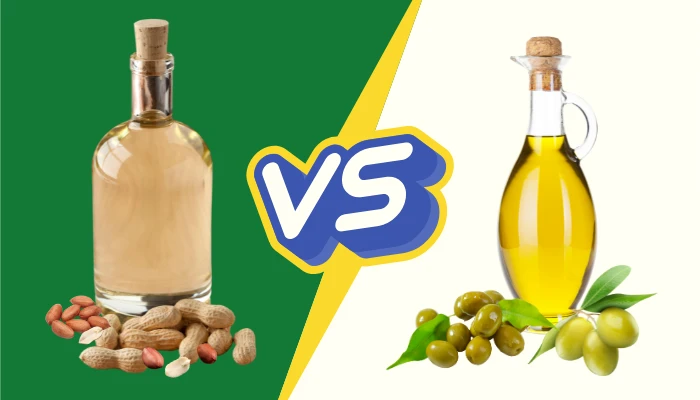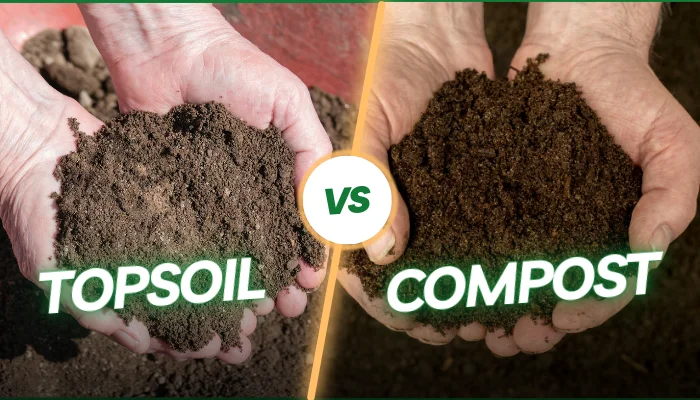When it comes to cooking oils, peanut oil and olive oil are both widely used heavyweights. Each has its distinct characteristics, uses, and health benefits. But what sets these oils apart, and which one is best for your needs?
The Basics: Peanut Oil and Olive Oil
Peanut oil is derived from peanuts, offering a mild, nutty flavor frequently used in Asian cuisines. It’s perfect for deep-frying and high-heat cooking because it has a high smoke point of around 450°F.
Olive oil, from olives, has a fruity taste with variants like extra virgin, virgin, and regular olive oil, each differing in flavor and smoke points. Extra virgin olive oil, the highest grade, is best for low-heat cooking and as a finishing oil, while regular olive oil can handle moderate to high heat.
Nutritional Profiles: A Closer Look
Olive oil is celebrated for its high content of monounsaturated fats, which are heart-healthy and help reduce bad cholesterol levels. It’s also packed with antioxidants and vitamin E. A tablespoon of extra virgin olive oil contains about 14 grams of fat, including 10 grams of monounsaturated fats and 1.5 grams of polyunsaturated fats.
Peanut oil, while also containing monounsaturated fats, has a higher proportion of saturated fats. A tablespoon has around 13.5 grams of fat, with 6.2 grams of monounsaturated fats and 4.3 grams of polyunsaturated fats. It also contains vitamin E and resveratrol, an antioxidant known for its anti-inflammatory properties.
Culinary Uses: What Each Oil Does Best
Peanut oil’s high smoke point makes it ideal for deep-frying, stir-frying, and any high-heat cooking. Its neutral taste doesn’t overpower dishes, making it a versatile choice in the kitchen. Think of making crispy French fries or a sizzling stir-fry – peanut oil handles the heat beautifully without breaking down.
And your french fries never taste like peanuts.
Olive oil, particularly extra virgin, is great in Mediterranean and Italian cuisine. Its rich, fruity flavor enhances salads, pastas, and grilled vegetables.
Regular or pure olive oil, with a higher smoke point, is best for sautéing and roasting. The distinct taste of extra virgin olive oil also makes it a great finishing oil. Drizzle over a dish just before serving to add a burst of flavor.
Health Considerations: Choosing the Healthiest Option
The American Heart Association recommends using oils high in monounsaturated and polyunsaturated fats to improve heart health.
Olive oil, especially extra virgin, tops the list with its high monounsaturated fat content and antioxidants. These components help reduce LDL (bad) cholesterol and the risk of heart disease.
Peanut oil, while beneficial in moderation, should be consumed with caution due to its higher saturated fat content. However, its vitamin E and resveratrol can support the immune system and protect against free radicals. It’s a good choice for those without peanut allergies, offering a healthier alternative to oils high in trans fats and saturated fats.
But, again, peanut oil should always be consumed in moderation.
Versatility and Storage: Making the Most of Your Oils
Both oils require proper storage to maintain their quality. Keep them in a cool, dark place away from direct sunlight and heat sources.
Once opened, use them within six months to ensure optimal flavor and nutritional benefits.
In terms of versatility, both peanut and olive oils can be substituted for each other in certain recipes, although the flavor profiles will differ. Olive oil imparts a fruity, grassy note, while peanut oil offers a subtle, nutty flavor.
For high-heat cooking, peanut oil is your go-to (and it’s cheaper), whereas you’ll want to use olive oil in dishes where its rich flavor can shine.
Cooking Methods: Best Practices for Each Oil
Knowing the best cooking methods for peanut oil and olive oil can help you get the most out of both versatile ingredients.
Peanut Oil
- Deep Frying: Peanut oil’s high smoke point makes it ideal for deep-frying. Foods like tempura, fried chicken, and French fries achieve a perfect crispy texture without the oil breaking down. Cold-pressed peanut oil, also known as groundnut oil, retains more nutrients and offers a richer flavor.
- Stir-Frying: Frequently used in Asian cuisine, peanut oil handles the high heat of stir-frying, ensuring that vegetables and meats cook quickly and evenly.
- Grilling: Peanut oil’s stable nature at high temperatures also makes it a great option for grilling. Brush it on meats and vegetables to prevent sticking and add a subtle nutty flavor.
Olive Oil
- Sautéing: Extra virgin olive oil excels in sautéing vegetables, meats, and seafood over medium heat. Its rich flavor enhances the dish without overpowering it. Extra light olive oil can be used for a more neutral taste.
- Roasting: Drizzle olive oil over vegetables, meats, or even fruits before roasting to add depth and prevent sticking. The moderate smoke point of regular olive oil makes it suitable for this method.
- Baking: Olive oil can replace butter or vegetable oil in baking, adding moisture and a subtle fruity flavor to cakes, muffins, and breads.
- Salad Dressings and Marinades: The robust flavor of extra virgin olive oil makes it perfect for vinaigrettes and marinades. Its healthy fats help absorb the nutrients from greens and other vegetables.
Health Comparisons: Detailed Breakdown
Cardiovascular Health
- Olive Oil: Rich in monounsaturated fats, olive oil is linked to lower LDL cholesterol levels and a reduced risk of heart disease. The antioxidants in extra virgin olive oil, such as polyphenols, further enhance its heart-protective properties.
- Peanut Oil: While peanut oil also contains heart-healthy monounsaturated fats, it has a higher percentage of saturated fats. However, it includes polyunsaturated fatty acids, which can be beneficial in moderation. Peanut oil’s vitamin E content supports overall heart health and helps maintain balanced blood pressure levels.
Impact on Blood Sugar Levels
- Olive Oil: Studies suggest that olive oil can help stabilize blood sugar levels, making it a good option for those managing diabetes. Its healthy fats slow down the absorption of sugar into the bloodstream.
- Peanut Oil: There’s evidence that peanut oil may help reduce blood sugar levels and improve insulin sensitivity. Incorporating peanut oil into a balanced diet could be beneficial for metabolic health.
Peanut Oil vs Olive Oil Comparison Chart
| Nutrient (per 1 tbsp) | Peanut Oil | Olive Oil |
|---|---|---|
| Calories | 119 | 119 |
| Total Fat | 14g | 14g |
| Saturated Fat | 2.3g | 1.9g |
| Monounsaturated Fat | 6.2g | 9.8g |
| Polyunsaturated Fat | 4.3g | 1.5g |
| Omega-3 Fatty Acids | 0g | 0.1g |
| Omega-6 Fatty Acids | 4.3g | 1.3g |
| Smoke Point | 450°F (232°C) | 375°F (191°C) (Extra Virgin) |
| Vitamin E | 2.1mg (14% DV) | 1.9mg (13% DV) |
Common Cooking Oils: Comparisons and Uses
There are more cooking oil options now than every before. Olive oil has been in use since at least 6,000 years ago along the eastern Mediterranean coast.
Peanut oil is far younger. It’s use dates back only to the early 1800s.
These days, if something can be crushed and turned into an oil, you can buy it from Walmart. In fact, we’ve already compared olive oil to corn oil.
Here’s how peanut oil and olive oil compare to five other popular oils:
- Vegetable Oil: Typically a blend of soybean oil and other oils, vegetable oil is a versatile and affordable choice. It has a high smoke point but lacks the distinct flavors of peanut or olive oil.
- Sesame Oil: Known for its strong nutty aroma, sesame oil is often used in Asian cooking for dressings and stir-fries. It has a lower smoke point and is best used as a finishing oil.
- Coconut Oil: With a high saturated fat content, coconut oil is solid at room temperature. It’s ideal for baking and high-heat cooking, offering potential health benefits, despite some controversy.
- Walnut Oil: Rich in omega-3 fatty acids, walnut oil is excellent for salad dressings and drizzling over finished dishes. Its low smoke point means it’s not suitable for cooking at high temperatures.
- Rice Bran Oil: This oil has a high smoke point and mild flavor, making it one of the best cooking oils for frying and stir-frying. It’s high in monounsaturated fats and vitamin E.
Storing Oils: Best Practices
Oil is not cheap. And we don’t like waste, so proper storage is will help you maintain the quality and flavor of cooking oils and extend their usefulness.
Here are some general rules that apply to most oils:
- Room Temperature: Most oils can be stored at room temperature in a cool, dark place. This helps prevent oxidation and the formation of harmful compounds.
- Refrigeration: Some oils, like walnut oil and flaxseed oil, are best kept in the refrigerator due to their high polyunsaturated fat content. These oils can go rancid quickly if not stored properly.
- Dark Containers: Use dark or opaque containers to protect oils from light exposure, which can degrade their quality over time.
Beyond the Basics: Exploring Other Healthy Oils
While peanut and olive oils are popular choices, there are other oils worth exploring.
Avocado oil, with its high smoke point and health benefits, is great for high-heat cooking and drizzling over salads.
Canola oil, low in saturated fats and high in omega-3 fatty acids, is another healthy option for everyday use.
Sunflower oil, rich in vitamin E, and grapeseed oil, known for its mild flavor and medium-high smoke point, are also excellent additions to your pantry.
The Verdict: Which Oil Reigns Supreme?
Olive oil is healthier, has more documented nutritional benefits, and 6,000 years of history doesn’t hurt either. So, olive oil is the winner.
Ultimately, the choice between peanut oil and olive oil depends on your cooking needs and health goals.
Olive oil, particularly extra virgin, is a top pick for its robust flavor and numerous health benefits. It’s perfect for salads, dressings, and low to medium-heat cooking.
Peanut oil, with its high smoke point and neutral flavor, is ideal for deep-frying and high-heat methods.
Incorporating a variety of oils into your diet can help you enjoy the unique flavors and health benefits each one offers. Whether you’re sautéing vegetables, deep-frying snacks, or dressing a salad, there’s an oil that fits your needs perfectly.
So next time you’re in the oil aisle at the grocery store, consider grabbing a bottle of each and experimenting with your recipes.














